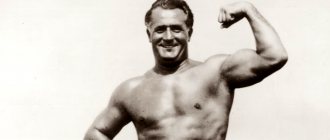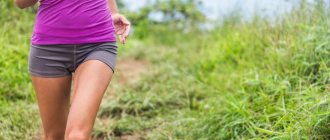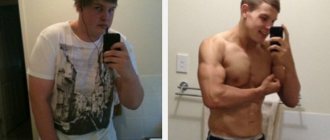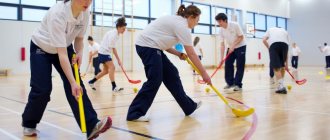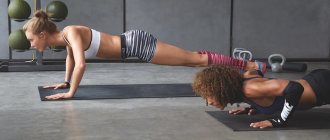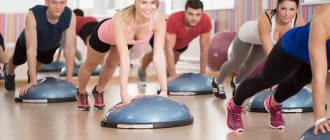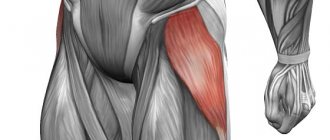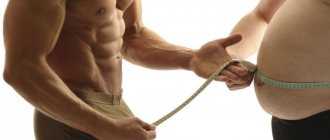STRUCTURE OF THE HUMAN SKELETON
ARMS - EXERCISES FOR ARM FLEXORS - BICEPS - EXERCISES FOR ARM FLEXORS - EXTENSORS - FOREARM - EXERCISES FOR ARM EXTENSORS - TRICEPS
SHOULDERS - EXERCISES FOR DELTOID MUSCLES
CHEST - EXERCISES FOR CHEST MUSCLES
BACK – EXERCISES FOR THE LATISM MUSCLES OF THE BACK – EXERCISES FOR THE LOWER BACK
LEGS - EXERCISES FOR LEG EXTENSERS - QUADRICEPS - EXERCISES FOR LEG FLEXORS - BICEPS FEMI - EXERCISES FOR HIP ADDUTORS - EXERCISES FOR CALF MUSCLES - CHINS
BUTTOCKS - EXERCISES FOR GUTTEAL MUSCLES
ABDOMINAL - EXERCISES FOR ABDOMINAL MUSCLES - PRESS
Anatomy of the Human Body and the Kinetic Chain in Fitness and Athleticism.
Did you know, our dear readers, that the cause of chronic knee pain may be in tight thigh muscles? Or that chronic neck problems and migraines may be due to weakness in your pectoral muscles? You are probably asking: “How can this be? “Tightened muscles in one part of the body cause pain somewhere in a completely different part of the body?” The answer is insanely simple. In our body and the anatomy of the human body, everything is interconnected...
If one of its elements is weakened or damaged, another tries to smooth out and compensate for this circumstance. Any area of our body is closely connected to another using a system that has a name: kinetic chain . And the source of your pain cannot be so easily identified if you cannot understand how the interaction of your fascia and the kinetic chain anatomically occurs.
What is a kinetic chain from a physics point of view? Kinetics in another way is movement (you probably learned at school that kinetic energy is the energy resulting from the movement of bodies). Your kinetic chain is a complex system that allows your entire body, from your feet to your toes, to make all sorts of movements. It involves muscles, fascia and other connective tissues that maintain its integrity. Some elements of the system are oriented to maintain mobility, others to maintain stability. All parts interact as one whole and are closely dependent on each other. When any one part is weakened, the other tries to compensate for this weakness, and as a result, the operation of the entire system is disrupted. If an area that is supposed to be mobile does not perform its main functions, another one takes over, but the next link in this anatomical chain turns out to be significantly weakened. It is for this reason that you are only as strong and strong as your weakest link in your kinetic chain.
Stability is the organized action of muscles, ligaments and tendons to hold a joint in a fixed position.
The anatomy of the human body states that the best functioning of the kinetic chain is ensured through the qualitative interaction of two interrelated principles: mobility and mobility of the joint, including both its physical movement in the amplitude of given movements, and the ability of the muscles to produce such work.
Take a look at the picture. It shows how the kinetic chain works. Do you see a repeating sequence of elements? The components of a circuit must alternately demonstrate stability and mobility . And optimal action is possible only when one area supports and helps the other. Just like the 11 players of a good football team protect and support each other, effectively representing a single whole.
Anatomy of the Kinetic Chain in our body.
If one of the links in our chain is broken or significantly weakened, the body will be able to compensate, but you will feel pain. For example, when tight quadriceps weaken the mobility of your leg in the hip joint, your spine provides the missing mobility. If your foot lacks stability, it can affect your knees, hips, spine, and your entire body.
Although anatomically any joint in our body is important in its own way for maintaining the performance of the whole organism, I would like to focus special attention on the hip area. If the thigh muscles are stiff and cannot function fully, you are on a direct path to all sorts of pain and injuries. Talk to sports medicine doctors whose patients include professionals who play outdoor games: football, hockey, tennis, etc. They will all say in unison that, regardless of the sports discipline and the nature of the injuries, in the vast majority of cases, all of these Athletes often have tight thigh muscles.
The six most common causes of all kinds of chronic pain
In our daily life there will always be factors that cause us all sorts of pain, although we may not even suspect it. All our fasciae are tightly intertwined with each other. Knowledge of the principles of their functioning alone can serve as a good weapon against pain, but in addition, we will give a couple of practical recommendations that will help counteract the most popular factors that destroy our body. What are these factors?
- a) Accumulation of stress;
- b) Sedentary lifestyle;
- c) Limitation of movements in the hip joints;
- d) Poorly selected training program;
- e) Weak stretching;
- f) Insufficient time for rest and recovery.
And now, in order...
- Accumulation of stress. There are a couple of types of stress:
- eustress (positive);
- distress (negative).
- Passive lifestyle. Nowadays, very few people spend the whole day on their feet. Most people sit - at computers, in meetings, at lunch, in an armchair watching TV. You spend entire hours and even days in one position. At the same time, your pelvic muscles, hamstrings and quadriceps muscles are absolutely motionless. The gluteal muscles are forced to bear your entire body weight. The chest muscles contract and pull the shoulders forward. The neck, shoulders and back receive increased stress; you slouch and hunch over. You can immediately forget about correct posture, because prolonged sitting is one of the most negative postures for a person. Poor posture negatively affects the fascia and deprives them of elasticity, which is so necessary from an anatomical point of view. The consequence of this is constant pain.
- Restricted mobility of the hip joints. Low mobility in the hip joints destroys the entire system. The pelvis is incredibly important for the performance and well-being of the entire body. When we talk about the hip joints, we firstly mean the muscles:
- rotating the leg outward (gluteal and piriform),
- inward (mainly the lumbar and pelvic floor muscles),
- as well as flexing the leg at the hip joint (mainly lumbar).
- Poorly designed training program. Often the injury that ends the career of many athletes is the straw that breaks the camel's back. If you are reading these lines, you are probably working out at the gym. However, have you ever thought that the exercises you do may significantly worsen the condition causing your pain? Do you pump up your back muscles with the same zeal as your chest and abdominal muscles? We recommend that the ratio here be 1:1. This means that for every “push” movement there should be one “pull” movement. In the world of fitness and athleticism, there is an expression: “mirror muscles.” These are the ones that you yourself see in the mirror and the formation of which you pay special attention to). We are talking about biceps, chest and abdominal muscles. But, being carried away by external beauty, do not forget that unipolarity in this matter will not allow you to fully reveal your full potential. You will significantly improve your fitness if you pay at least the same amount of attention to those muscles that are located behind and hidden from your eyes.
- Weak stretch. The average person, even those leading an active lifestyle, has significant problems with flexibility, especially in the area of the above hip joint, as well as the posterior thigh muscles and thoracic spine. Moreover, the older you get, the more visible these problems are. Think about it: what part of the training do you usually throw away when time is running out? That's right, stretching. However, the lack of stretching exercises leads to muscle stiffness, discomfort, all kinds of pain and injuries. As a result, all the efforts spent on training go down the drain.
- Insufficient time for recovery and rest. By changing your approach to training, you are taking a step in the right direction. But this is only one side of the coin. It is impossible to qualitatively strengthen the body through training alone. You also need time for rest and recovery. Give your body the opportunity to replenish its energy reserves. The components of this process rightfully include nutrition, sleep and exercise to increase flexibility. It is important to understand that recovery is an active process. You must make some efforts to help your body overcome the stress accumulated during work in the gym, including those that were created artificially by you (during training). Constantly repeating cyclic monotonous movements are considered one of the main causes of fascial contraction. Therefore, once again: rest, recovery, replenishment of energy.
Yes, it turns out that there is “good” stress, and we need it for optimal performance, because, whatever one may say, stress goes hand in hand with any achievements. Remember how you played football as a child. After all, you are fighting with friends and thinking: “We need to hit this ball 100 pounds!” Here is an example of positive stress. It helps us overcome existing difficulties.
Unlike positive stress, distress is purely negative. Excessively elevated levels can lead to illness. Some circumstances always give rise to negative stress (tight deadlines at work, illness of a child, quarrel with a wife or girlfriend, taxes, mortgage, etc.). And sometimes even positive stress becomes too much, and it transforms into negative.
If you constantly live under stress, then feelings of anxiety, anger, rage, irritability, and disappointment arise. Such emotions trigger the “flight or fight” mechanism in our body. Stress hormones such as adrenaline and cortisol are actively released into the blood, and the body falls out of balance. Blood pressure soars, breathing quickens, becomes shallow, and all muscles from the neck to the legs are tense. This tension creates discomfort and subsequently causes pain.
The pelvic girdle is of paramount importance for overall body mobility. The cascading relationships between the muscles that flex and rotate the leg at the hip joint have a profound effect on dozens of small muscle groups in the pelvic floor that not only help flex and rotate the leg, but also stabilize the spine. All these muscles are connected to each other by fascia.
In fact, you are depriving yourself of much-needed flexibility because you are not exercising. True, it can also be a lack of exercise or improperly organized physical training that creates a muscular imbalance (for example, if you pay more attention to the formation of the chest muscles than the back).
Sometimes the problem is not at all a lack of flexibility or muscle tightness. Perhaps it's all about your fascia, or maybe it's about the instability of the muscles surrounding your spine. The result is a limitation in the range of motion. However, if you develop these muscles correctly, it will become much easier to move, and at the same time the lost flexibility will increase. Pay attention to your weak points and you will achieve success.
So, we have looked at the main factors. The problems have been identified. But don’t be upset - every problem has a solution! We can make you happy. Even if your body has become flabby, and everyday negative habits cannot serve as a role model, the problem can be solved. But you need to change something in yourself. Tangible results will come with the acquisition of knowledge and regular efforts. In other words, you need to learn to understand your body and also take active actions. Which? – we will definitely tell you on the pages of our fitness website. Keep reading us, we have a lot more interesting things!
- < Back
- Forward >
HANDS
ANATOMY OF HANDS
EXERCISES FOR ARM FLEXORS - BICEPS
01. ALTERNATING ARM CURLES WITH DUMBBELLS 02. CONCENTRATED ONE-ARM CURL WITH A DUMBBELL 03. HAMMER GRIP ARM CURL WITH DUMBBELLS 04. ONE-ARM CURL WITH LOWER BLOCK HANDLE 05. ARM CURL WITH A HAMMER GRIP WITH THE HANDLES OF THE UPPER BLOCKS 06. BENDING THE ARMS WITH THE BAR BELL 07 BARREL CURL 08. LARRY SCOTT ARM CURL 08. LARRY SCOTT BARREL CURL 09. OVERHAND GRIP BAR CURL
EXERCISES FOR HAND FLEXORS -
FOREARM
10. WRIST EXTENSION WITH A BARbell WITH AN OVERGROUND GRIP 11. WRIST FLEXION WITH A BARLESS WITH AN UNDERGROUND GRIP
EXERCISES FOR ARMS EXTENSIONS - TRICEPS
12. ARM EXTENSION WITH THE UPPER BLOCK HANDLE WITH AN OVER GRIP 13. ARM EXTENSION WITH THE UPPER BLOCK HANDLE WITH AN UNDERGROUND GRIP 14. ONE ARM EXTENSION WITH THE UPPER BLOCK WITH AN UNDERGROUND GRIP 15. ARM EXTENSION WITH A BARLESS LYING —
FRENCH BENCH PRESS 16. ARM EXTENSION WITH DUMBELLS BEHIND THE HEAD 17. ONE ARMS EXTENSION WITH A DUMBBELL BEHIND THE HEAD 18. ARM EXTENSION WITH ONE DUMBBELL BEHIND THE HEAD 19. ARM EXTENSION WITH A CURVED BAR BAR FROM -BEHIND THE HEAD - FRENCH PRESS STANDING (SITTING
) ) 20. ONE-ARM BACKWARD EXTENSION WITH A DUMBBELL IN AN INCLINED 21. TRICEPS PUSH-UP WITH YOUR BACK TO THE BENCH
SHOULDERS
SHOULDER ANATOMY
EXERCISES FOR DELTOID MUSCLES
01. BEHIND THE HEAD PRESS 02. SEATED CHEST PRESS - SHOULDER INJURIES - 1 - SHOULDER INJURIES - 2 - DUMBELL PRESS 03. SEATED DUMBELL PRESS 04. ALTERNATING DUMBBELL PRESS WITH WRIST ROTATIONS 05. LIFT WEIGHT THE DUMBBELLS TO THE C SIDE FORWARD TILT 06. LATERAL DUMBELL RAISES-1 06. LATERAL DUMBELL RAISES-2 07. ALTERNATIVE DUMBBELL FORWARD RAISES 08. ONE-ARMED LATERAL RAISES 09. ONE-ARM LATERAL RAISES LOWER BLOCK 10. ONE-ARM LIFT FORWARD FROM THE LOWER BLOCK STANDING 11. CROSS ARM SWINGS BACKWARDS FROM UPPER BLOCKS 12. CROSS ARM SWINGS BACKWARD FROM LOWER BLOCKS 13. FORWARD ARM RAISES WITH ONE DUMBBELL 14. FORWARD BAR RAISES 15. SHOULDER FRONT PULL - CHIN PULL
16. ARM RAISES TO THE SIDEWAYS ON THE EXAMINER 17. SWING YOUR ARMS BACKWARDS WITH THE MACHINE HANDLES
Author
The book “Anatomy of Strength Exercises” is the work of not just a scientist, but a talented athlete, French weightlifting champion - Frederico Delavier. In addition, the author is a specialist in comparative anatomy. This fact suggests that everything contained in the book is a description of many years of practice and invaluable experience. That is why Delavier's works are considered one of the most authoritative in this field.
Today, Frederico Delavier is a co-author and editor of well-known sports publications in Europe.
Delavier's work “Anatomy of Strength Exercises” is a personal trainer for every reader. The advantage of the book is that it will not only help you create the right training program, but also teach you to understand your body. In addition, all the exercises described in the book will allow you to build muscle as effectively as possible, which is one of the main goals of strength sports.
BREAST
EXERCISES FOR CHEST MUSCLES
01. BAR PRESS, LYING ON AN INCENTED BENCH - RUPTURE OF THE Pectoralis Major MUSCLE 02. BAR PRESS, LYING ON A HORIZONTAL BENCH - 1 02. BAR PRESS, LYING ON A HORIZONTAL BENCH - 2 03. BAR PRESS NARROW X WATCH, LYING ON A BENCH - TRICEPS PRESS
— PAIN IN ELBOW WHEN BENCH PRESSES 04. BAR PRESS, LYING ON A BENCH WITH AN INCLINE 05. PUSH-UPS 06. PUSH-UPS 07. DUMBELL PRESS 08. DUMBELL FLIES 09. DUMBELL PRESS LYING ON THE BENCH PUBLISH BENCH 10. DUMBBELL FLIES , LYING ON AN INCENTED BENCH 11. ARM FLIGHT ON THE EXAMINER 12. UPPER BLOCK FLIGHT
- CROSSOVER ON BLOCKS
13. DUMBELL ROLL FROM BEHIND THE HEAD LYING
- PULLOVER WITH A DUMBBELL
14. BAR TRAFFLE LYING
- PANT PULLOVER GOY
Cardio and strength training for women. Debunking myths
Myth 1. All exercises are clearly divided into cardio and strength.
This is wrong. Any exercise can only conditionally be called cardio or strength. They do not exist in their pure form. And that's why:
- For aerobic exercise, the only source of energy is oxygen, but at the very beginning of its implementation you have to use muscle fuel, and this is already a strength load.
- For anaerobic exercise, oxygen is not needed at first, because muscle energy is consumed, but it lasts for no more than 12 seconds, and then the body begins to burn... oxygen, and this is already cardio.
So strength and cardio training does not exist in its pure form. Their division is based on which of the described methods of obtaining energy predominates. And here other parameters come into play - the duration and intensity of the load. For example, a regular morning run without stopping and at a constant pace is aero. But sprinting will be classified as anaerobic.
Myth 2. Cardio is for weight loss, strength training is for muscles.
And that's not true. Yes, strength training doesn't burn as many calories as cardio. But they contribute to the growth of muscle mass, and the body requires a colossal amount of energy for this. That is, with aerobic exercise, you lose weight while you do it. Anaerobic exercises allow you to use up fat reserves 24 hours a day, since muscles are formed even between classes.
If you constantly do only cardio, you can lose a little weight only in the first month of classes. Further weight loss will stop, and the breakdown of muscle mass will also begin if you do not combine them with strength loads in time.
Myth 3. Cardio is for women, strength training is for men.
This is nothing more than social prejudice. Both men and women should be able to properly combine cardio and strength training in order to achieve a beautiful, sculpted body, lose weight and improve health. Without aerial exercises, men will not be able to work on their endurance, and the heart may not be able to withstand such colossal loads. In the same way, without anaerobic exercise, girls would turn into anorexics without muscle mass, with sunken chests and skinny stringy limbs.
The conclusion suggests itself: you need to be able to combine them correctly. This will allow both men and women to get a beautiful, sculpted figure against the backdrop of good health.
BACK
ANATOMY OF THE BACK MUSCLES
EXERCISES FOR THE LATISM MUSCLES OF THE BACK
01. PULL-UPS ON A BAR WITH AN UNDERGROUND GRIP 02. PULL-UPS ON A SPECIAL BAR 03. UPPER BLOCK ROLL-OUTS IN FRONT TO YOUR CHEST 04. UPPER BLOCK PULL-OUTS BEHIND THE HEAD - TRICEPS TEARS 05. UPPER BLOCK ROLL-OUTS TIGHT GRIP 06. UPPER BLOCK PULL-OUTS WITH STRAIGHT ARMS 07. LOWER PULL-OUTS SEATED BLOCK TO THE WAIST 08. ONE-ARMED DUMBELL ROLL-OUTS 09. STANDING BENT-UP BARREL ROLL-OFFS 10. T-BAR ROWLES 11. T-BAR ROWLES WITH SUPPORT
EXERCISES FOR THE LOWER BACK - TORSO EXTENSORS
12. “DEAD” LIFT WITH A BAR, LEGS STRAIGHT 13. “DEAD” IN SUMO STYLE 14. DEADLIFT WITH A BAR – 1 14. DEADLIFT WITH A BAR – 2 – RUPTURES OF THE BICEPS BRAIMISE TENDON – 1 – REARS OF THE BICEPS BRAIMS BICEPS SHOULDER JOINTS – 2 – LUMBAGO - SHOULD YOU ARCH YOUR BACK? 15. LUMBAR DEFLECTION - HYPERIXTENSION
16. TORSO EXTENSIONS ON THE MACHINE 17. VERTICAL PULL-UP RAILS UP TO THE CHIN 18. SHRUGS WITH A BAR 19. SHRUGS WITH DUMBBELLS 20. SHRUGS ON THE MACHINE
LEGS
ANATOMY OF LEGS MUSCLES
EXERCISES FOR LEG EXTENSIONS – QUADRICEPS
01. SQUATS WITH DUMBELLS 02. SQUATS WITH A BAR ON THE CHEST 03. SQUATS WITH A BAR ON THE SHOULDER - 1 03. SQUATS WITH A BAR ON THE SHOULDER - 2 04. WIDE SQUATS - INTERVERTEBRAL DISC HERNIATION 05. INCLINED LEG PRESS AMI 06. SQUATING ON A MACHINE 07. LEG EXTENSION
EXERCISES FOR LEG FLEXORS - BICEPS TEMORAL
08. LYING LEG FLEXION 09. STANDING SINGLE LEG FLEXION 10. SITTING LEG FLEXION – ISCHIO-POTELLAIT MUSCLE TEARS 11. TORSO RAISES – GOOD MORNINGS
EXERCISES FOR THE HIP ADDUTORS
12. ONE LEG ADDRUSION STANDING 13. LEG ADDRESS SITTING
EXERCISES FOR CALF MUSCLES - CHINS
14. STANDING TOE RAISES 15. SINGLE LEG TOE RAISES STANDING 16. STANDING TOE RAISES - “DONKO”
17. SEATED SHIN EXTENSION 18. SITTED SHIN EXTENSION WITH A BAR ON YOUR KNEES
BUTTOCKS
STRUCTURE FEATURES OF THE HUMAN BUTTOCKS
EXERCISES FOR THE GLUTEUS MUSCLES
01. LUNCHES WITH A BAR ON THE SHOULDER 02. LUNCHES WITH DUMBBELLS - INSTABILITY OF THE KNEE JOINT 03. BACKWARD LEG SWINGS FROM A LOWER BLOCK 04. BACKWARD LEG SWINGS WITH A MACHINE LEVER 05. BACKWARD LEG SWINGS ON THE FLOOR 06. “BRIDGE” LYING 07. LEG SWING B SIDE FROM THE LOWER BLOCK - INDIVIDUAL MOBILITY OF THE HIPS 08. LEG SWINGS TO THE SIDE WITH THE EXAMINER LEVER 09. LEG SWINGS TO THE SIDE, LYING ON YOUR SIDE 10. LEG BREAKDOWN ON THE MACHINE
What should cardio workouts be like?
Cardio on machines
If your body mass index is higher than normal, you should not run on a treadmill: this will put too much stress on your joints. Instead, choose a brisk uphill walk (you can adjust the incline on the treadmill), exercise bike, elliptical, stepper or airbike.
Perform cardio at a moderate intensity so that you can last without slowing down. The main thing is to increase your heart rate and keep it at this level for the right time.
If long, monotonous cardio makes you sad, try doing it with headphones. If this doesn't help, choose intense circuit training with your own weight. They are also suitable for those who cannot go to the gym five times a week.
Circuit training
Circuit training is when you perform several exercises in a row on different muscle groups, usually with little or no rest, and then start over. Circular training is good because it allows you to reduce rest time: some muscles have time to recover while others are working, and your heart rate remains elevated, as does calorie expenditure.
STOMACH
ANATOMY OF THE ABDOMINAL MUSCLES
EXERCISES FOR ABDOMINAL MUSCLES - PRESS
ATTENTION! 01. TORSO ROLLUP ON THE FLOOR 02. TORSO RAISES 03. TORSO RAISES AT THE GYMNASTIC WALL 04. TORSO ROLLUP WITH SHINS ON A BENCH 05. TORSO RAISES ON AN INCENTED BENCH 06. RAITS TORSO ON A VERTICAL BENCH 07. TORSO ROLL-UP WITH UPPER BLOCK 08. TORSO ROLL-UP ON THE MACHINE 09. LEG RAISES ON AN INCENTED BENCH 10. KNEE RAISES 11. HANGING KNEE RAISES 12. TORSO TURN OUT WITH A BAR 13. LATERAL TORSO RAISES STANDING 14. LATERAL TORSO RAISES ON ROMAN CHAIR 15. ROTATION OF THE TORSO WHILE STANDING ON THE TWIST MACHINE »
« Books on bodybuilding
Who is this book for?
Due to its detailed descriptions, this manual has gained popularity among various groups of people involved in physical education. In addition to bodybuilders and trainers, “Anatomy of Strength Exercises” has become popular among physical therapy students. This is partly due to the fact that the author presents scientific concepts in a very accessible form. This is especially useful for beginners.
For those who have decided to take up strength exercises, focus on them, or include them in an existing training program, this manual will be a good help.
For example, in the West, this book received a grand prize in the field of sports technology and training theory, and also became very popular among coaches as a teaching aid for athletes.
